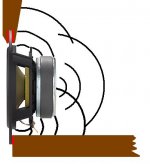If you don`t want to be disturbed by the rear wave, make the Baffle BIG.
http://www.phy-hp.com/English/Communication_E/Com_E_Baffle_Plan.html
http://www.phy-hp.com/English/Communication_E/Com_E_Baffle_Plan.html
If you don´t want to be disturbed by secondary sound sources from the baffle edge - make the baffle SMALL. 😉
http://www.diyaudio.com/forums/showthread.php?postid=1244143#post1244143
Rudolf
http://www.diyaudio.com/forums/showthread.php?postid=1244143#post1244143
Rudolf
terry j said:I vote for being all confused....
we've gone from big, to small, to none.

Well I think I get what you're saying and there's no "one size fits all" solution.
Limiting the box size is all about tuning the bass response, usually so that the Qtc is around 0.5 to 0.707. If you plan on EQing the response with active filters then that issue becomes less important.
However, using an extremely large box/ infinite baffle is all about optimizing the midrange~treble response, which might be a bit counter-intuitive but hey. IMO one important thing to look out for is Accidental horn loading of the back-wave.
Check out the picture. (5" Visaton mid-bass that I might use) The top half has a wide baffle, which gives a smooth and fast expansion rate, whereas the bottom half is a bit wacky because of the tight fit. If you can imagine it in 3d so the speaker is boxed into a corner, it could have some nasty resonances in the 1~5kHz range. Not only that, but the reflections would also be amplified as they travel back towards the speaker.
Attachments
- Status
- Not open for further replies.
